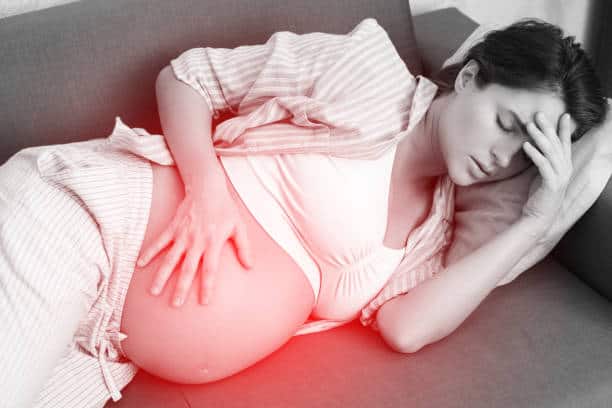Pregnancy is a time of many questions and concerns for expecting mothers. One question that may arise is, can you go into labor while sleeping? The answer is yes, it is possible for labor to begin while a woman is sleeping.
Understanding labor is an important part of preparing for childbirth. Labor is the process by which the uterus contracts to push the baby out of the birth canal.
It is a natural process that can be unpredictable and may start at any time, including while sleeping. Physical signs of labor include contractions, water breaking, and cervical dilation.

Key Takeaways
- Labor can start while a woman is sleeping.
- Physical signs of labor include contractions, water breaking, and cervical dilation.
- Techniques to induce labor, preparing for the hospital, and pain management during labor are important aspects of childbirth preparation.
1. Understanding Labor

Labor is the process by which a woman’s body prepares for and gives birth to a baby. It is a complex process that involves a series of physical and hormonal changes.
The onset of labor is usually marked by contractions, which are rhythmic tightening and relaxing of the uterine muscles.
During pregnancy, the cervix remains closed and firm. However, as labor approaches, the cervix begins to soften and thin out, a process known as effacement.
This is followed by dilation, which is the opening of the cervix to allow the baby to pass through.
Early labor is characterized by mild contractions that are irregular and may be accompanied by lower back pain and cramps. These contractions are often referred to as Braxton Hicks contractions and are not usually painful.
As labor progresses, the contractions become more frequent and intense, and the cervix continues to dilate. This is known as active labor and is typically the most painful stage of labor.
It is during this stage that the baby is born.
There are several signs of labor to look out for, including the water breaking, which is the release of the amniotic fluid that surrounds the baby. Another sign is the loss of the mucus plug, which is a thick, jelly-like substance that seals the cervix during pregnancy.
Labor can be induced for various reasons, such as if the pregnancy has gone past the due date or if there are medical complications. Inducing labor involves the use of medications or other methods to stimulate contractions.
In summary, labor is a natural process that involves several stages, including early labor, active labor, and the birth of the baby. It is marked by contractions, cervical dilation, and various signs such as the water breaking and the loss of the mucus plug.
Inducing labor is sometimes necessary but should only be done under medical supervision.
2. Labor Start While Sleeping

It is possible for labor to start while sleeping. Contractions can begin during sleep, and the pregnant person may wake up in active labor.
However, it is important to note that most labors do not start while sleeping.
The position in which a pregnant person sleeps may affect the likelihood of labor starting while sleeping. Sleeping on the back is generally not recommended during pregnancy, as it can cause discomfort and potentially decrease blood flow to the fetus.
Additionally, sleeping on the back later in pregnancy can increase the risk of stillbirth. Sleeping on the left side is often recommended, as it can improve blood flow to the fetus and help prevent certain pregnancy complications.
Comfort is also an important factor in labor starting while sleeping. If a pregnant person is not comfortable while sleeping, they may be more likely to wake up during contractions.
It is important to find a comfortable sleeping position during pregnancy to promote better sleep and potentially reduce the risk of labor starting while sleeping.
In summary, labor can start while sleeping, but it is not common. The position in which a pregnant person sleeps and their comfort level may play a role in the likelihood of labor starting while sleeping.
3. Physical Signs of Labor

As labor approaches, the body undergoes several physical changes that indicate the onset of labor. These changes can occur gradually or suddenly, and they can vary from woman to woman.
Here are some of the common physical signs of labor:
- Burst of Energy: Some women experience a sudden burst of energy before going into labor. This can happen a few days or hours before labor starts and is often referred to as the “nesting instinct.”
- Back Pain: Back pain is a common symptom of labor. It can be caused by the pressure of the baby’s head on the lower back or by the contractions themselves.
- Low Back Pain: Low back pain is also a common symptom of labor. It is often caused by the baby’s position in the pelvis and can be relieved by changing positions.
- Diarrhea: Some women experience diarrhea before labor. This is thought to be the body’s way of clearing the bowel before delivery.
- Baby Drops: When the baby drops, or engages in the pelvis, it can cause increased pressure on the bladder and pelvis. This can lead to increased urination and discomfort.
- Ligaments: As the cervix begins to dilate, the ligaments in the pelvis and lower abdomen may stretch and cause discomfort.
- Uterine Muscles: As labor begins, the uterus begins to contract and relax. These contractions can be felt as cramping or tightening in the abdomen.
- Lightening: Lightening refers to the baby’s descent into the pelvis. This can cause a noticeable change in the shape of the abdomen and may make breathing easier.
- Vaginal Discharge: As the cervix begins to dilate, the mucus plug that has been sealing the cervix may be expelled. This can cause a thick, jelly-like discharge.
It is important to note that not all women will experience these physical signs of labor, and some women may experience them differently. If you are unsure if you are in labor, it is best to contact your healthcare provider.
4. Techniques to Induce Labor

There are several techniques that are believed to induce labor. However, it is important to note that not all of them are backed by scientific evidence.
It is always recommended to consult with a healthcare provider before trying any of these techniques.
Sex
Sexual intercourse is believed to help induce labor due to the hormone prostaglandin found in semen. Prostaglandin can help ripen the cervix and prepare it for labor.
However, there is no conclusive evidence to support this claim.
Walking
Walking is a low-impact exercise that may help induce labor. The movement of the baby’s head against the cervix can help stimulate contractions.
However, there is no scientific evidence to support this claim.
Curb Walking
Curb walking is a variation of walking that involves walking up and down a curb. It is believed to help stimulate contractions by increasing pressure on the cervix.
However, there is no scientific evidence to support this claim.
Nipple Stimulation
Nipple stimulation is believed to help release the hormone oxytocin, which can help stimulate contractions. However, it is important to note that excessive nipple stimulation can lead to prolonged contractions and fetal distress.
Exercise Ball/Birthing Ball
Sitting on an exercise ball or birthing ball and gently bouncing or swaying can help stimulate contractions by putting pressure on the cervix. However, there is no scientific evidence to support this claim.
Castor Oil
Castor oil is a laxative that is believed to help stimulate contractions by causing diarrhea. However, it is important to note that castor oil can cause dehydration and should only be used under the guidance of a healthcare provider.
Spicy Food
Eating spicy food is believed to help induce labor by causing contractions in the intestines, which can then lead to contractions in the uterus. However, there is no scientific evidence to support this claim.
5. Preparing for the Hospital

When a woman is pregnant, it is important to prepare for labor and delivery. One aspect of this preparation is packing a hospital bag.
This bag should include items such as comfortable clothing, toiletries, and any necessary paperwork.
It is also important to have a plan in place for getting to the hospital. This may involve arranging transportation or having a designated driver.
It is recommended to have a backup plan in case the primary plan falls through.
When arriving at the hospital, the woman will be checked in and taken to a delivery room. The healthcare provider will monitor the baby’s heart rate and the woman’s contractions.
If necessary, pain relief options will be discussed.
The healthcare provider will also check the woman’s cervix to determine if she is ready to deliver. If the cervix is not fully dilated, the woman may be given medication to help speed up the process.
If the woman is unable to deliver vaginally, a cesarean section may be necessary. In this case, the healthcare provider will explain the procedure and any potential risks.
At the Mayo Clinic, the staff is trained to provide high-quality care during labor and delivery. They will work with the woman to create a personalized birth plan and ensure that all of her needs are met.
6. Pain Management During Labor

Pain management during labor is an important consideration for many women. While some women choose to have a natural birth without pain medication, others opt for pain relief options to make the process more manageable.
One common pain management option is an epidural. This involves the injection of medication into the lower back, which numbs the nerves that carry pain signals from the uterus and cervix.
Epidurals can provide effective pain relief, but they can also have side effects, such as low blood pressure and a longer second stage of labor.
Other pain relief options include analgesics, which are pain medications that can be given through an IV or injection. These medications can help to reduce pain, but they can also cause drowsiness and nausea.
In addition to medication, there are also non-pharmacological pain management techniques that can be used during labor. These include:
- Breathing techniques, such as slow breathing or patterned breathing
- Massage and touch therapy
- Relaxation techniques, such as visualization or meditation
- Water therapy, such as taking a bath or shower
It’s important for women to discuss their pain management options with their healthcare provider prior to labor and delivery. This can help to ensure that they are informed about the risks and benefits of each option and can make an informed decision about what is right for them.
7. Possible Complications

While it is possible for a woman to go into labor while sleeping, there are some potential complications that may arise. These complications can range from minor to severe and may require medical intervention.
One possible complication is infection. If the amniotic sac ruptures while the woman is sleeping, bacteria can enter the uterus and cause an infection.
This can lead to fever, chills, and other symptoms. In some cases, antibiotics may be necessary to treat the infection.
Another potential complication is a tear in the uterus or cervix. This can occur if the baby is in an abnormal position or if the woman has a weak cervix.
In severe cases, a c-section may be necessary to deliver the baby safely.
In some cases, the placenta may detach from the uterine wall before the baby is born. This is known as placental abruption and can cause heavy bleeding and other complications.
In severe cases, an emergency C-section may be necessary.
Growth abnormalities in the baby can also lead to complications during labor. If the baby is too large or too small, it may be difficult to deliver vaginally.
In some cases, a C-section may be necessary to ensure the safety of both the mother and the baby.
It is important for women to discuss the potential risks and complications of labor with their healthcare provider. Regular prenatal care can help identify and manage any potential complications before they become more serious.
8. Post-Labor Rest and Recovery

After giving birth, rest and recovery are crucial for the mother’s health and well-being. The body has gone through an intense physical experience, and it needs time to heal.
It is normal to feel exhausted and overwhelmed after giving birth, and it is essential to take the time to rest and recover.
The first few days after giving birth are usually the most challenging. The mother may experience fatigue, soreness, and discomfort.
It is essential to rest as much as possible during this time and to avoid any strenuous activities. The mother should also try to sleep when the baby sleeps to ensure she gets enough rest.
It is common for the mother to experience some discomfort in the perineum area after giving birth. The perineum is the area between the vagina and the rectum, and it can become sore and swollen during childbirth.
Ice packs and pain medication can help reduce the discomfort and swelling.
The mother may also experience some bleeding after giving birth. This bleeding, called lochia, is normal and can last for several weeks.
It is essential to use pads instead of tampons during this time to avoid any infections.
In the first few days after giving birth, the mother may also experience the urge to push when she goes to the bathroom. This is because the rectum can become swollen during childbirth, and it can take some time to return to its normal size.
It is important to avoid straining during bowel movements to prevent any further discomfort.
Overall, rest and recovery are crucial after giving birth. The mother should take the time to rest and recover, and not push herself too hard.
It is essential to listen to the body and take care of oneself to ensure a healthy recovery.
Frequently Asked Questions
Can you go into labor while sleeping?
Yes, it is possible to go into labor while sleeping. Contractions can start at any time, including during the night. However, many women wake up when labor begins due to the intensity of the contractions.
Can you sleep during active labor?
It is possible to sleep during early labor, but once active labor begins, it may be difficult to sleep due to the intensity of the contractions. It is important to conserve energy during early labor by resting, but once active labor begins, it is important to stay alert and focused.
Can you sleep through contractions with an epidural?
With an epidural, it is possible to sleep through contractions as the pain is greatly reduced. However, it is important to stay alert and aware of any changes in the baby’s heart rate or other complications.
Can labor start suddenly?
Yes, labor can start suddenly without warning signs. Some women experience a gradual onset of contractions, while others experience a sudden onset.
Can labor start without water breaking?
Yes, labor can start without the water breaking. In fact, only about 10% of women experience their water breaking before labor begins.
Will I wake up if I go into labor at night?
It is possible to wake up when labor begins due to the intensity of the contractions. However, some women may sleep through early labor and wake up when contractions become more intense. It is important to have a plan in place for when labor begins, including how to get to the hospital or birth center.

Iesha is a loving mother of 2 beautiful children. She’s an active parent who enjoys indoor and outdoor adventures with her family. Her mission is to share practical and realistic parenting advice to help the parenting community becoming stronger.
